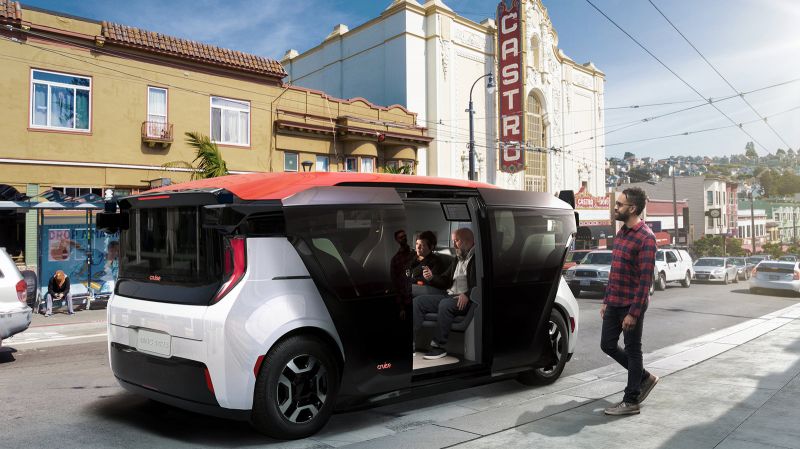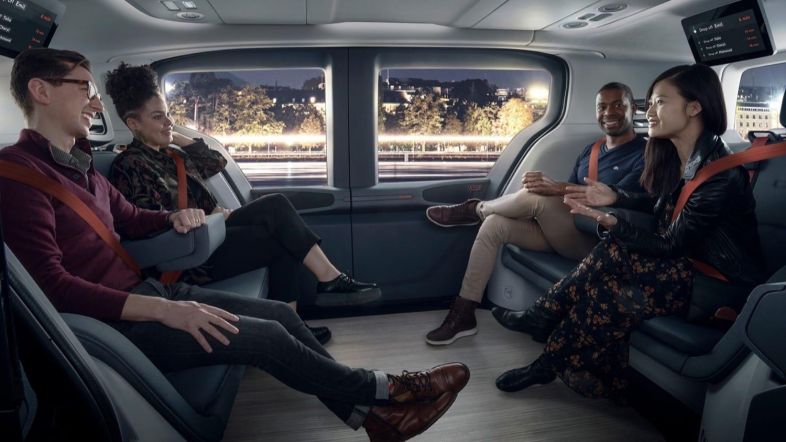General Motors' Autonomous Driving Unit Cruise is Seeking NHTSA Approval to Deploy Vehicles Without Steering Wheels or Brake Pedals
【Summary】General Motors’ autonomous driving unit Cruise has petitioned the U.S. National Highway Traffic Safety Administration (NHTSA) for permission to deploy the Cruise Origin driverless shuttle on roads in the U.S. as part of a commercial ride-hailing service that’s similar to Uber. The Origin is the first production vehicle purposefully built by a global automaker without a steering wheel or brake pedal.

General Motors' autonomous driving unit Cruise has petitioned the U.S. National Highway Traffic Safety Administration (NHTSA) for permission to deploy its driverless shuttles as part of a commercial ride-hailing service that's similar to Uber.
The plans were shared in a recent blog post by Cruise SVP Government Affairs and Social Impact, Rob Grant.
GM partnered with Japan's Honda Motor Co to design and build its self-driving shuttle called the "Cruise Origin". The vehicle was first unveiled in Jan 2020 and is not equipped with controls for a human driver. It's the first production vehicle purposefully built by a global automaker without a steering wheel or brake pedal.
The intent of the Origin was to reimagine transportation. Cruise envisioned the Origin to serve as a new form of shared transportation built on an entirely new platform. The petition to the NHTSA signals that Cruise, GM and Honda are now ready to build and deploy the Origin.
"We look forward to NHTSA's thorough review of our petition, and stand ready to continue working closely with them to ensure the safe and responsible deployment of this technology," Cruise wrote in its blog post.
The fully-electric Origin was designed with passenger comfort in mind, unlike traditional cars where the passenger compartment is designed around the vehicle's mechanical systems. Without human controls and an internal combustion engine to work around, engineers at Honda and GM were able to open up the passenger space significantly.
The Cruise Origin fits six passengers and is roomy and comfortable inside, with minimalist design throughout. The vehicle is no bigger than an average SUV. However, without the design limitations of an engine, exhaust system, and fuel tank and driver controls of a traditional vehicle, Cruise, GM and Honda were able to design the Origin making full use of the space it takes up on the road.

The Cruise Origin was built from the ground up for autonomous mobility, therefore human driver controls are not needed, although they are mandated for all passenger vehicles sold and registered in the U.S.
Current rules require that all passenger vehicles have features such as steering wheels, brake pedal, mirrors, windshield wipers, sun visors, airbags and more. However, the NHTSA assumes that these vehicles will be operated by a human, which is not the case for the Cruise Origin.
Although the NHTSA has made clear in public testimony and regulatory actions, that in order to develop standards for autonomous vehicles (AVs), it will need more information from real world deployments. It's sort of a Catch-22 situation, where autonomous vehicles can improve road safety, but there are currently no regulations in place governing their use in commercial mobility services. Cruise wants the NHTSA to create new updated regulations and standards specifically for AVs.
Cruise believes that its AVs address the U.S. Department of Transportation's six guiding principles for innovation in transportation, including environmental sustainability, U.S. leadership in developing and manufacturing autonomous technology, artificial intelligence, supporting the American workforce and promoting accessibility.
In addition, the Origin will be manufactured at GM's Factory ZERO electric vehicle manufacturing facility in Michigan, which supports the creation of American jobs, economic growth, and advancing the long-term success of the U.S. manufacturing sector and America's automotive industry.
In Sept 2021, Cruise was granted a permit from the California Department of Motor Vehicles (DMV) to deploy commercial self-driving vehicles carrying paying customers. The permits pave the way for a more broader deployment of autonomous ride-hailing services in the San Francisco Bay Area.
The new deployment permit allows companies to make its autonomous technology commercially available outside of a testing program. But GM will need approval to deploy the Origin without driver controls in order to scale its ride-hailing business to other cities in the U.S.
In June of last year, Cruise announced plans to access a $5 billion line of credit to finance the purchase of tens of thousands of Origin shuttles. The funds will be made available through GM's automotive financing arm, GM Financial.
The $5 billion line of credit will finance the expansion of the Cruise fleet over the next several years. But autonomous vehicles won't enter mass production unless they can be deployed legally, which is now the work of the NHTSA.
In 2016, GM invested roughly $1 billion for a majority stake in Cruise when it was still a relatively unknown San Francisco startup working on self-driving technology. Part of GM's investment was intended to jumpstart its own work on self-driving technology.
-

Two Ford Crown Victorias Still Operating as Taxis in NYC
-

Mazda CEO's Opinion on EV Adoption in the U.S.
-

Hyundai's revolutionary powertrain design
-

Sustainability focus urged by Michelin Fleet Panel
-

BM Catalysts' UK Expansion
-

Warwick University's £12m funding for electric vehicle battery progress
-

Executive X Series: Unveiling the Powerful City/Vios Competitor
-

Hollywood couple defies expectations, showing affection after 20 years
- Mercedes-Benz is Partnering with Game Engine Developer Unity Technologies to Create Immersive, 3D Infotainment Screens and Displays for its Future Vehicles
- BorgWarner Invests $500 Million in Wolfspeed Inc, a Developer of Semiconductors and Silicon Carbide Devices for Electric Vehicles
- Audi Rebrands its Premium Car Rental Service to ‘Audi on demand’
- Tesla Rival XPeng Inc. to Start Deliveries of its New Flagship G9 Electric SUV in September, CEO Confirms After Sharing New Details
- Hyundai and Michelin to Develop Next-Gen Tires for EVs
- Hyundai Gets Serious About Electric Performance Cars, Shows off Two Concepts
- SK Inc. Invests $100 Million in North Carolina-based EV Charging Hardware Developer Atom Power
- Tesla Raises Prices in the U.S. as Inflation Chips Away at its Profit Margins
- China Has Installed Around 4.7 Million Electric Vehicle Charging Poles as of October 2022
- Ford CFO Claims Inflation Has Erased Mustang Mach-E Profits



















 About Us
About Us Contact Us
Contact Us Careers
Careers